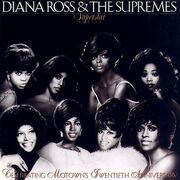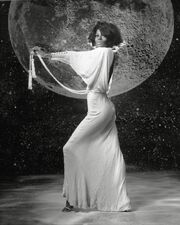
"The Supremes," an American female singing group, were the premier act of Motown Records during the 1960s. Originally founded as "The Primettes" in Detroit Detroit, Michigan, in 1959, Theremes' repertoire included Doo-wop, Pop, Soul, Broadway, Show tunes, Psychedelic soul, and Disco. They were the most commercially successful of Motown's acts and are, to date, America's most successful vocal group with 12 number one singles on the Billboard Hot 100. Most of these hits were written and produced by Motown's main songwriting and production team, Holland–Dozier–Holland. At their peak in the mid-1960s, The Supremes rivaled "The Beatles" in worldwide popularity, and their success made it possible for future African-American R&B and soul musicians to find mainstream success. Over 18 years, a total of 8 women contributed to the legacy of "The Supremes."
Personnel {1961-1977}[]

Diana Ross {1959-1970}

Mary Wilson {1959-1977}

Florence Ballard {1959-1967}

Cindy Birdsong {1967-1970, 1972-1976}

Jean Terrell {1970-1973}


Lynda Laurence {1972-1973}
Scherrie Payne {1973-1977}

Susaye Greene {1976-1977}
Overview[]
Originally from the Brewster-Douglass Projects of Detroit, Michigan, "The Supremes" became the first black female performers of the rock era to embrace a more feminine image. Much of this was accomplished at the behest of Motown chief Berry Gordy and Maxine Powell, who ran Motown's in-house finishing school and Artist Development department. Unlike many of her contemporaries, Ross sang in a thin, calm voice, and her vocal styling was matched by having all three women embellish their femininity instead of imitate the qualities of male groups such as growling and heavy-voiced gospel shouting. Eschewing plain appearances and basic dance routines, "The Supremes" in contrast appeared onstage in detailed make-up and expensive wigs, and personally manufactured gowns hirsute with sequins, rhinetsones, beads, and semi-precious stones. The trio also performed graceful choreography created by Motown choreographer Cholly Atkins. Powell told the group to "be prepared to perform before kings and queens." Gordy wanted "The Supremes," like all of his performers, to be equally appealing to both black and white audiences, and he sought to erase the image of black performers as being unrefined or lacking class. At the time, with the exception of "The Beatles," "The Supremes" were the only popular vocal group being marketed for the individual personalities of each member. Thus, many Supremes fans not only knew the names of each Supreme, but also knew other fan facts such as their own individual hobbies and their favorite singers. On the album, "More Hits by the Supremes," each member is pictured separately on the front, with her signature above it. By 1965, "The Supremes" were international stars. They toured the world, becoming almost as popular abroad as they were in the U.S. Besides England, the trio also charted several singles in such countries as Ireland, Sweden, Switzerland, and Holland. Almost immediately after their initial number-one hits, the group began recording songs for motion picture soundtracks such as 1965's "Beach Ball" (in which they also made a special guest appearance), 1966's "Dr. Goldfoot & The Bikini Machine," and "The Happening" (the latter of which brought them their tenth #1 pop hit. The trio also endorsed dozens of products, at one point even having their own brand of white bread. That year the group also released "The Supremes A' Go-Go," which became the first album by an all-female group to reach number one on the U.S. Billboard 200, and knocking The Beatles' Revolver out of the top spot. Because "The Supremes" were popular with white audiences as well as with black ones, Gordy had the group cater to its middle American fan base by grooming the women for performances at renowned supper clubs such as the "Copacabana" in New York. Broadway and pop standards were incorporated into their repertoire alongside their own hit songs. As a result, "The Supremes" became one of the first black musical acts to achieve complete and sustained crossover success. Black rock and roll musicians of the 1950s had seen many of their original hit tunes covered by white musicians, with these covers usually achieving more fame and sales success than the originals. The Supremes' success, however, counteracted this trend. Featuring three group members who were marketed for their individual personalities (a move unprecedented at the time) and Diana Ross’ pop-friendly voice, "The Supremes" broke down racial barriers with rock and roll songs underpinned by R&B stylings. The group became extremely popular both domestically and abroad, becoming one of the first black musical acts to appear regularly on television programs such as "Hullabaloo," "The Hollywood Palace," "The Della Reese Show," and most notably, "The Ed Sullivan Show," (on which they made a total of 17 appearances.) Overseas, they appeared on television shows in such places as France and England, including "Top of The Pops" on the BBC.
Legacy[]
The Supremes' cross-cultural success effectively paved the way for the mainstream success of contemporaneous label mates such as "The Temptations," "The Four Tops" and "The Jackson 5." With two Grammy-Award nominations, an NAACP Image Award, 12 #1 U.S. Pop hit singles, 7 top ten charted studio albums (3 of which went to #1), two television specials, and international acclaim, "The Supremes" finally disbanded in 1977 after an 18-year run.